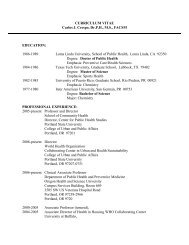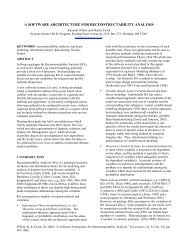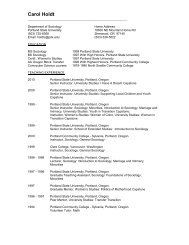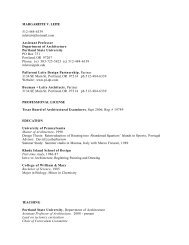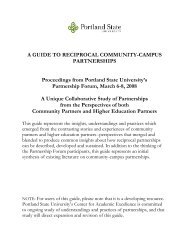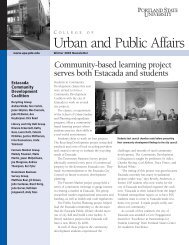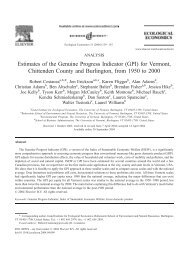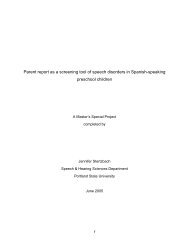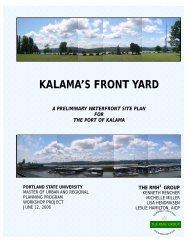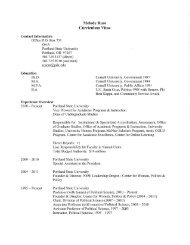Effects of integral stimulation therapy on speech - Portland State ...
Effects of integral stimulation therapy on speech - Portland State ...
Effects of integral stimulation therapy on speech - Portland State ...
Create successful ePaper yourself
Turn your PDF publications into a flip-book with our unique Google optimized e-Paper software.
The committee recognized that identificati<strong>on</strong> <str<strong>on</strong>g>of</str<strong>on</strong>g> diagnostic features and<br />
efficacious treatments for the <strong>speech</strong> disorder is particularly difficult because<br />
characteristics <str<strong>on</strong>g>of</str<strong>on</strong>g> CAS may change significantly over the course <str<strong>on</strong>g>of</str<strong>on</strong>g> a child’s development<br />
and treatment history.<br />
Characterizati<strong>on</strong> <str<strong>on</strong>g>of</str<strong>on</strong>g> CAS first appeared as a result <str<strong>on</strong>g>of</str<strong>on</strong>g> similarities that were noted<br />
between the childhood form <str<strong>on</strong>g>of</str<strong>on</strong>g> apraxia and the acquired adult form <str<strong>on</strong>g>of</str<strong>on</strong>g> apraxia <str<strong>on</strong>g>of</str<strong>on</strong>g> <strong>speech</strong><br />
(AOS) (Morley,1972). Acquired Apraxia <str<strong>on</strong>g>of</str<strong>on</strong>g> Speech involves cortical damage (most <str<strong>on</strong>g>of</str<strong>on</strong>g>ten<br />
associated with strokes or other neurological insults) resulting in difficulty with voliti<strong>on</strong>al<br />
motor sequencing <str<strong>on</strong>g>of</str<strong>on</strong>g> <strong>speech</strong> movements (Chapey, 2001). Like AOS, childhood apraxia <str<strong>on</strong>g>of</str<strong>on</strong>g><br />
<strong>speech</strong>’s core deficit is believed to involve the disrupti<strong>on</strong> <str<strong>on</strong>g>of</str<strong>on</strong>g> motor planning and/or motor<br />
executi<strong>on</strong> processes (Caruso & Strand, 1999; Nijland, Maassen & van der Meulen, 2003).<br />
However, there has been no definitive delineati<strong>on</strong> linking the neurological etiology <str<strong>on</strong>g>of</str<strong>on</strong>g><br />
AOS with CAS. In additi<strong>on</strong> to motor deficits, implicati<strong>on</strong>s <str<strong>on</strong>g>of</str<strong>on</strong>g> core deficits in language<br />
processing have been suggested by many in the field <str<strong>on</strong>g>of</str<strong>on</strong>g> <strong>speech</strong>-language sciences (Aram<br />
& Nati<strong>on</strong>, 1982; Crary, 1984; Dewey, 1995; Velleman & Strand, 1994). There is<br />
disagreement as to whether the linguistic symptoms associated with CAS should be<br />
c<strong>on</strong>sidered a core deficit <str<strong>on</strong>g>of</str<strong>on</strong>g> the disorder, or whether linguistic impairments arise as a<br />
result <str<strong>on</strong>g>of</str<strong>on</strong>g> underlying sensory motor impairment (Hall, Jordan, & Robin, 1993). Lewis,<br />
Freebairn, Hansen, Iyengar, and Taylor, (2004) found that children diagnosed with CAS<br />
are likely to present with expressive and receptive language deficits and experience<br />
impaired academic performance in areas <str<strong>on</strong>g>of</str<strong>on</strong>g> reading, spelling, and written expressi<strong>on</strong>.<br />
2



